| Article ID | Journal | Published Year | Pages | File Type |
|---|---|---|---|---|
| 8304768 | Biochimie | 2015 | 12 Pages |
Abstract
About 70% of patients with idiopathic membranous nephropathy (iMN) have autoantibodies to the phospholipase A2 receptor PLA2R1. We screened sera from iMN patients for their cross-reactivity to human (h), rabbit (rb) and mouse (m) PLA2R1 by western blot (WB) and antigen-specific ELISAs. All iMN patients recognized hPLA2R1 and rbPLA2R1 by WB, and a rbPLA2R1 ELISA was as sensitive as the standardized hPLA2R1 ELISA to monitor anti-PLA2R1 in patients with active disease or in drug-induced remission. In contrast, only 51% of patients were reactive to mPLA2R1 by WB, and a maximum of 78% were weakly to highly positive in the mPLA2R1 ELISA, suggesting that iMN patients exhibit different subsets of anti-PLA2R1 autoantibodies against epitopes that are shared or not among PLA2R1 orthologs. In a cohort of 41 patients with a mean follow-up of 42 months from anti-PLA2R1 assay, the detection of anti-mPLA2R1 autoantibodies was an independent predictor of clinical outcome in multivariate analysis (p = 0.009), and a ROC curve analysis identified a threshold of 605 RU/mL above which 100% of patients (12 patients) had a poor renal outcome (p < 0.001). A similar threshold could not be defined in hPLA2R1 and rbPLA2R1 ELISAs. We conclude that rbPLA2R1 is an alternative antigen to hPLA2R1 to measure anti-PLA2R1 in active disease while mPLA2R1 is a unique antigen that can detect a subset of anti-PLA2R1 autoantibodies present at high levels (>605 RU/mL) only in iMN patients at risk of poor prognosis, and is thus useful to predict iMN outcome.
Keywords
Related Topics
Life Sciences
Biochemistry, Genetics and Molecular Biology
Biochemistry
Authors
Barbara Seitz-Polski, Guillaume Dolla, Christine Payré, Nicola M. Tomas, Marine Lochouarn, Louise Jeammet, Christophe Mariat, Thierry Krummel, Stéphane Burtey, Cécile Courivaud, Wolfgang Schlumberger, Kévin Zorzi, Sylvia Benzaken, Ghislaine Bernard,
